Whoops can make or break a race, or a fun day of riding for that matter. They are also the hardest terrain to master, as there are no two alike, and can change over the course of a day.
We spoke to Levi Marana, who races for Temecula Motorsports, for input and a demonstration on the subject. He pointed out one thing to keep in mind when attacking any kind of whoop section; “Stay loose and let the bike work under you so you don’t get tired, and adjust your style for different types of whoops.” He added that a rider should always hit them straight on, stay on the gas once committed, and lean back to keep the weight on the rear tires.
SUPERCROSS STYLE WHOOPS
Supercross whoops are the most challenging since they tend to be very large. If the peaks are spaced close enough together, a rider may be able to skim over the tops of the bumps. But once committed, do not hesitate, as loss of control or a crash will result if the front end of the ATV drops.
Other supercross sections will need to be tackled in a rhythm (rhythm sections). There are infinite variations of rhythm sections. For example, it may be best to double all the whoops. Other rhythm sections may require singling the first whoop, then doubling the middle ones, and tripling out. The famous Loretta Lynn’s “Ten Commandments” whoop section is well known for its ever-changing combinations of rhythms every year.
WASHBOARD OR SKIMMING WHOOPS
Probably the easiest of whoops, these are usually more evenly spaced and a rider can keep the throttle pinned through them. Marana prefers coming into these obstacles a gear high so he can power out of them.
BRAKING BUMPS
Staying in control through these whoops that develop on the entrance of a corner may be as simple as hanging on tight. However, as they worsen, a rider may have to coast into the corner with constant throttle through the bumps and brake late. The braking bumps can become so severe, a mix of techniques may be needed to negotiate them fast and under control. One such example would be to stab the brakes before the whoops, then let off the brakes and apply steady throttle to avoid suspension packing. Follow with late braking in the corner.
One such example would be to stab the brakes before the whoops, then let off the brakes and apply steady throttle to avoid suspension packing. Follow with late braking in the corner.
ACCELERATION BUMPS
Acceleration whoops develop on the exit of a corner or at the landing of jumps. It’s best to negotiate them like any other bump section. Keep the front-end light and power through them. However, when rough terrain develops after a jump, it may be necessary to begin jumping farther to clear the whoops. Another method, if possible, would be to jump shorter to allow setting up for rough stuff. If neither is really possible, then be prepared to hang on and stay steady on the throttle upon landing.
DESERT OR TRAIL WHOOPS
These whoops will vary the most since they develop naturally throughout a race. They can be a mix of all the whoop styles, and Marana says, “You attack desert whoops one-at-a-time and keep the quad under control.”
CONCLUSION
Pounding through whoops can be extremely fun and offer a rewarding sense of accomplishment. But they can also be the cause of some of the worst wrecks. So, as with hitting jumps, master this obstacle in steps and don’t get in over your head. Practice and apply the appropriate techniques to develop a sense of how to best to negotiate the terrain effectively and safely. Soon, experience will take over and properly negotiating that next bump ahead will be automatic!
But they can also be the cause of some of the worst wrecks. So, as with hitting jumps, master this obstacle in steps and don’t get in over your head. Practice and apply the appropriate techniques to develop a sense of how to best to negotiate the terrain effectively and safely. Soon, experience will take over and properly negotiating that next bump ahead will be automatic!
Continue Reading
Here you have it: a plethora of pros giving you their hard-won riding tips, secrets, and advice. They’ll fill you in on cornering, jumping, riding the whoops and good brake technique. Whether you are a casual rider or hard-core racer, these pro tips can improve your riding skills. Take what you read here and utilize the tips on the track and trails. Whether you race motocross or cross-country, shred dunes or just explore the trails, what the pros here have to say can help you ride better.
DOUG GUST,
Motocross Racer
JUMPING
When jumping, you want to keep the bike low.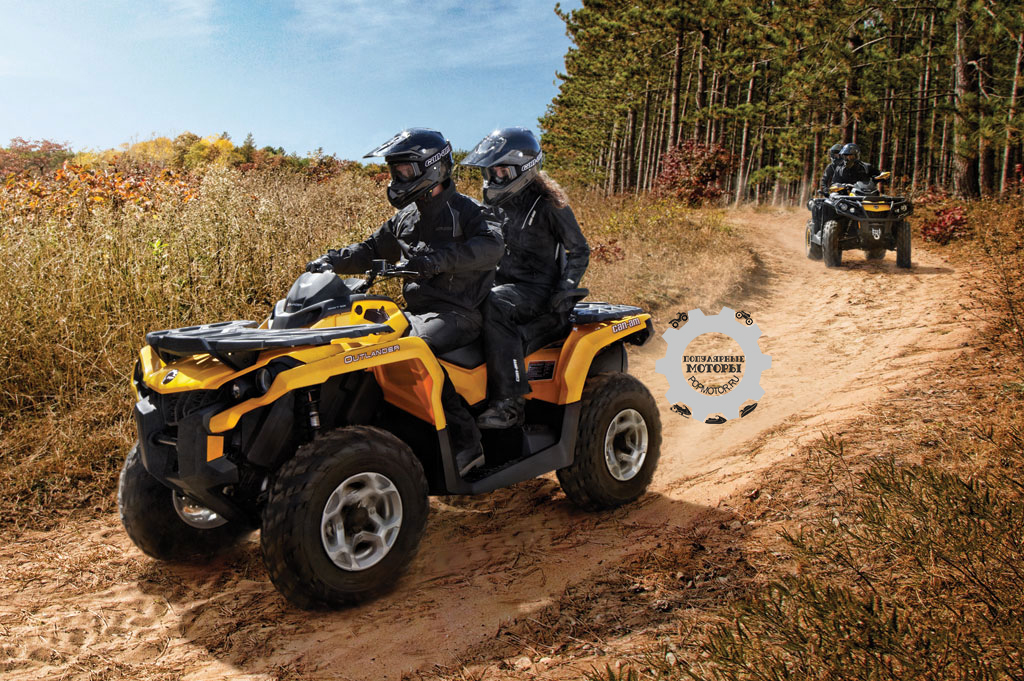 There are two reasons for that. One is, if you’re high, it’s that much longer before the wheels are on the ground and you’re moving forward. So I like to stay low when I can.
There are two reasons for that. One is, if you’re high, it’s that much longer before the wheels are on the ground and you’re moving forward. So I like to stay low when I can.
The second reason is you don’t want to get hurt! You’re there to win a race, not to be freestyling! I watch the guy in front of me carefully, because if it looks like he’s going to back off at the last second and not take the jump, I have to be able to get around him and still have the speed to take the jump successfully.
You want to use your body, both your arms and legs, as suspension. Use them to absorb landings as well as to preload the bike on the ramp. Don’t jump stiff.
Basically, use your head. It’s real easy to get hurt if you come up short on a double or get too crazy. It’s good to practice jumping in a non-race environment.
BRAKING/CORNERING
It’s true that whoever can out-brake the competition will win a race. What that means is, the later you can brake into a corner, the better.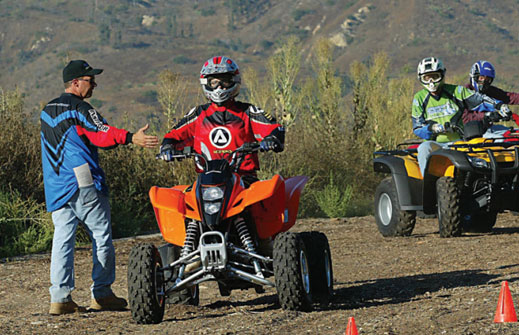 Don’t brake too late, of course, or you’ll find yourself eating a hay bale. So you go in fast, brake late, accelerate fast, and you lose less speed.
Don’t brake too late, of course, or you’ll find yourself eating a hay bale. So you go in fast, brake late, accelerate fast, and you lose less speed.
Keep your body weight back, way back, when braking. Brake equally, both front and rear, and don’t lock them up. Stay smooth.
WHOOPS
Like braking, keep your weight back on the quad. Try to stay balanced with the balls of your feet centered on the pegs. Suspension setup is important. Too slow a rebound setting and the shocks will pack; they won’t return to full travel in time for the next whoop. If it’s too fast, you can go over the bars. So you need to tweak your shocks before you race.
DOUG’S QUAD
Keep your quad in good shape and well-tuned. My Nacs Z-400 is running great; Yoshimura has done such a great job with it. Whether you work on your bike yourself or have a shop mod it, keep it tuned and you’ll have less of a chance for mechanical failures.
SHANE HITT,
Motocross/TT Specialist
JUMPING
First off, stay smooth and try to land on the downside of every jump. There are different kinds of jumps and I use different strategies for them. On doubles, I’ll go faster and get higher to make sure I clear the second jump. But for tabletops and singles, I try to stay low. Airtime is lost time except for double jumps. You want to get back on the ground and get the tires moving you forward.
There are different kinds of jumps and I use different strategies for them. On doubles, I’ll go faster and get higher to make sure I clear the second jump. But for tabletops and singles, I try to stay low. Airtime is lost time except for double jumps. You want to get back on the ground and get the tires moving you forward.
BRAKING/CORNERING
In TT and motocross, brake late. Usually, the harder you go in, the better off you are. Stay smooth and in control. Roll on the throttle. The best thing is not to follow the racer in front of you. If he is going wide in a turn, go inside and swoop him. And if he takes the inside, brake later in the corner, keep your speed up and try to cut him off from the outside line.
Never lock your brakes in TT. By far the best thing to do is brake in a straight line. I’ve found that if you’re sliding, you lose too much distance and time. Go fast and brake hard while still going straight. If you use the rear brake and slide, it actually takes longer for the bike to slow down, and you’re setting yourself up to be passed.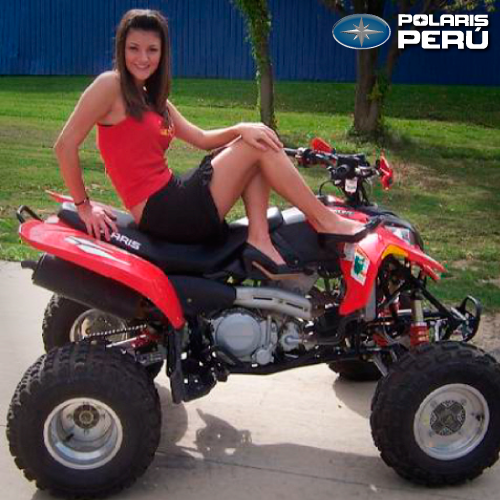
WHOOPS
Some whoops require a rhythm approach while others you want to skip over at speed. For whoops that are deeper and further apart, it’s best to do them in a smooth, rhythmic way. But for whoops that are shorter and closer together, you want to take them faster and skip across the top. If you have a run at whoops, it’s usually better to take them as fast as possible. I know that sounds scary, but it works. Whereas if the whoop section is right after a corner, you may not have time to get up to speed, and you’ll want to use a more rhythmic style to stay fast and smooth.
SHANE’S QUAD
I’m on a Walsh-framed 250R with a brand-new engine. I was wondering if the two-strokes could keep up with the four-strokes, but Jeremiah Jones has been dominating this year, so it looks like they can. I like the Pro Production class, though. I think that’s where the sport may be headed.
SCOTT KILBEY,
Cross-Country 4×4 Racer
CORNERING/BRAKING
Cut the corners as close as possible.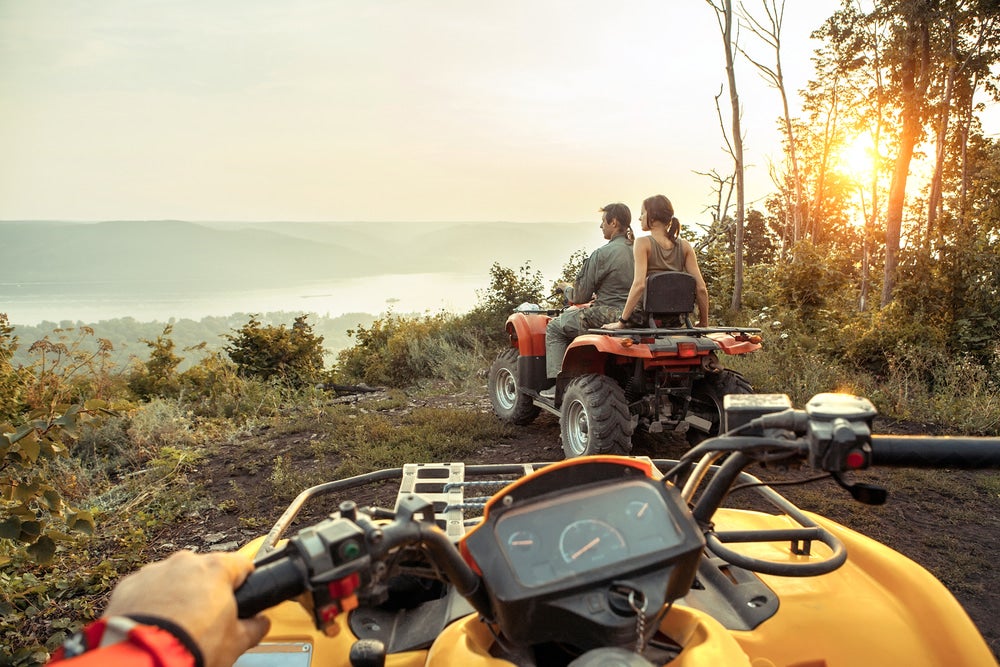 On a 4×4 the front wheels will push and dive in, so you need to put maximum body weight to the opposite side. But I don’t use the 4WD too much, unless there are extreme conditions, heavy bottlenecks on hills, that sort of thing. So in 2WD you can swing a corner a little wider and let the back end swing around. Come into the corner at speed and tap the front brakes to plant the front end, then tap the rears to get the rear wheels sliding. At about the halfway point in the turn, get off the brakes and back on the gas. It takes practice to keep your momentum up in a turn.
On a 4×4 the front wheels will push and dive in, so you need to put maximum body weight to the opposite side. But I don’t use the 4WD too much, unless there are extreme conditions, heavy bottlenecks on hills, that sort of thing. So in 2WD you can swing a corner a little wider and let the back end swing around. Come into the corner at speed and tap the front brakes to plant the front end, then tap the rears to get the rear wheels sliding. At about the halfway point in the turn, get off the brakes and back on the gas. It takes practice to keep your momentum up in a turn.
WHOOPS
For whoops sections on a cross-country course keep your weight back. Let the front end float over the whoops. That can be hard on a heavy 4×4 quad with no clutch, so it’s body weight back along with keeping on the throttle. You want to try to skim across the top of whoops but that’s hard on a 4WD quad. If you can’t skim, if the whoops are big, just roll smooth as you can. In the smaller whoops, power through them.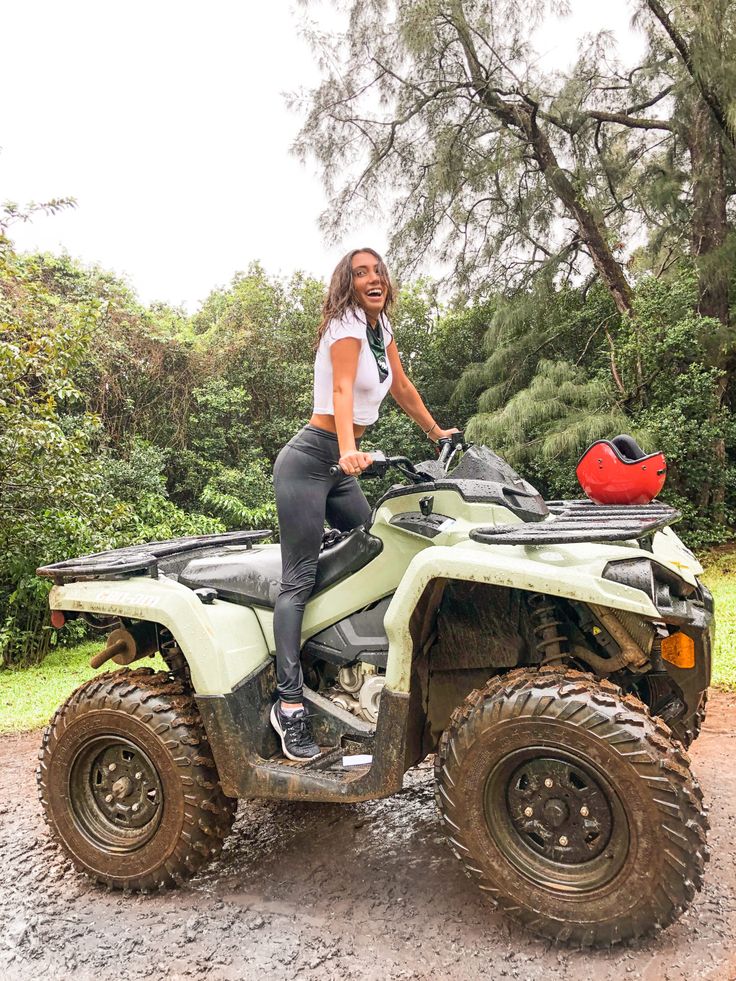 Be careful because the whoops can toss you and you don’t want a heavy 4WD quad landing on you.
Be careful because the whoops can toss you and you don’t want a heavy 4WD quad landing on you.
On my Kawasaki Prairie, I keep the front shocks stiff. The rear is fine, if anything I’ll set it to be soft just to save my body the punishment.
MUD
Stay clean! Stay in front. Pick your lines well. In a tight pack, you just have to take the mud and deal with it as you set up your passes. Usually by the second lap the pack has thinned out some and the mud won’t be as bad. Be prepared to pass because you don’t want to spend any more time than you have to being showered with mud. Make sure you have enough tear-offs or roll-offs!
WATER CROSSINGS
Ease into the water a bit slower; don’t just charge into a water crossing the first time. There could be rocks, logs, or it could just be deeper than you thought. You don’t want to drown your quad or go over the bars in water, or tear your bike and body up. Go a bit slower in, then accelerate out.
TIGHT TREE SECTIONS
If there are two trees you have to pass between, don’t look back and forth between the two trees; focus on one and get as close as you can to that one.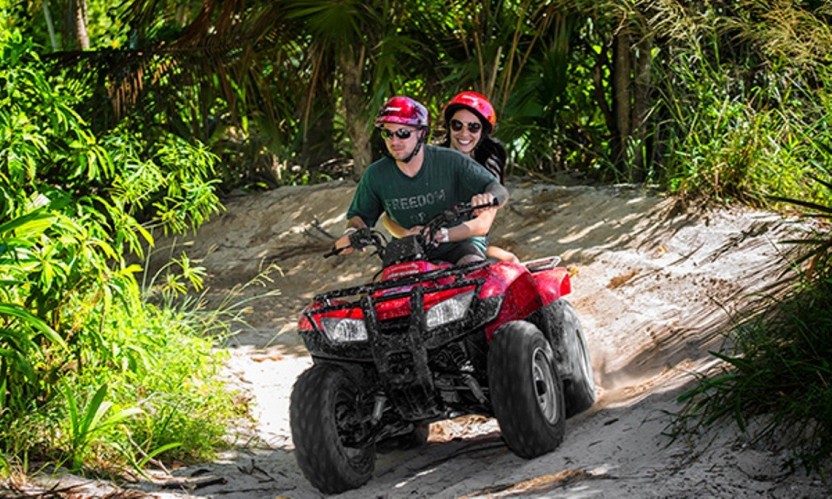 Then focus on the trail ahead. Peripheral vision is critical in tight spots. You have to be able to peripherally look at trees while you also watch the trail. It’s good to have strong upper body strength to maneuver a utility quad through tight sections.
Then focus on the trail ahead. Peripheral vision is critical in tight spots. You have to be able to peripherally look at trees while you also watch the trail. It’s good to have strong upper body strength to maneuver a utility quad through tight sections.
SCOTT’S QUAD
I’m on a Kawasaki-sponsored Prairie 4×4, hopped up by Penland Brothers Racing. It’s a 650 frame but I’m using a V-Force 700 engine. It’s actually the 650 cases with 700 internals.
DANA CREECH,
Motocross Racer
JUMPING
Rule number one: don’t land on anyone! I learned that fast, and the hard way. There’s no quicker way to get knocked out of a race. But you just want to pick a good line. If you’re unsure, watch the pack, watch the leaders, and see where they’re jumping. Follow for a while and figure out the good line. Then set them up and pass them over a jump.
BRAKING/CORNERING
Body english is the key to cornering well. You want to lean hard into those corners! That and good throttle/clutch control.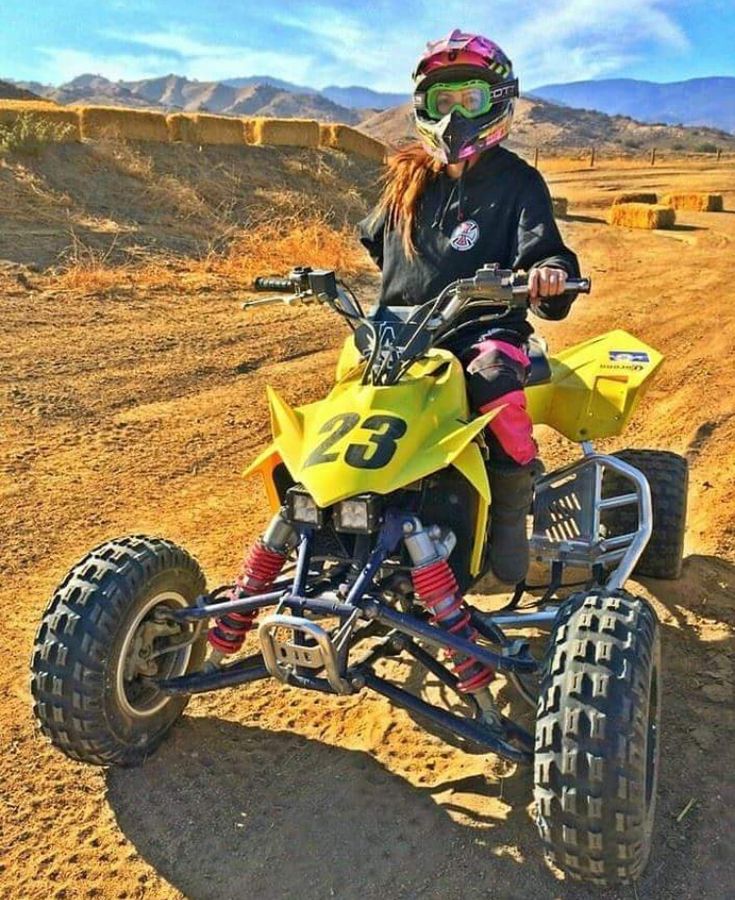 You should be leaning hard but still stay smooth around a corner. It just takes practice.
You should be leaning hard but still stay smooth around a corner. It just takes practice.
I use mostly my front brakes as I enter a corner. I always stay on the throttle hard, so my brakes take a beating. I push the rear with the throttle while dragging on the front brakes. I’ll use the rears, too, if I have to. I did that a lot when I was new but now I find that I use mostly the front brakes.
WHOOPS
You want your butt as far back as you can get it. Way back out there! Keep the front end up and light. You do that with throttle and body english. Your arms should be fully extended. You want to avoid pogoing through the whoops. I run PEP shocks and I’ve never even had to mess with them. But if you’re having problems you might want to slow down the rebound a bit.
DANA’S QUAD
CRF-450 engine with a Walsh frame.
CHAD DUVALL,
Cross Country Racer
CORNERING/BRAKING
Corners to me are getting from point A to point B as fast as possible, so I go into the corners hard and fast. I try to hold on to the last second to brake. It’s how you pick up a second here, a second there, as you outbrake your opponents. Frankly, it’s one of the best ways to win a race, if you’re quick in the turns. You need to use the turns in a cross-country race to make up time.
I try to hold on to the last second to brake. It’s how you pick up a second here, a second there, as you outbrake your opponents. Frankly, it’s one of the best ways to win a race, if you’re quick in the turns. You need to use the turns in a cross-country race to make up time.
Brake before the corner and be gassing it through the turn. Using your front brakes is better. I could lose my rear brakes and still finish a race in good position, but if I lose my fronts I just head for the trailer.
WHOOPS
Be aggressive and fast. Lean back and try to wheelie from whoop to whoop. I use Elka shocks and I keep them stiff with a good bit of rebound dialed in. Remember to stay smooth, because the smoother you are, the less fatigued you’ll get. You’ll need that strength at the end of the race when everyone else is getting tired. The fresher you, the faster you can go at the end.
MUD
Have fun and enjoy it. Everyone else is as miserable as you so you may as well have some fun. Some guys fall apart in the mud; they can’t handle it.
Some guys fall apart in the mud; they can’t handle it.
WATER CROSSINGS
Be smart if you’re crossing a deep water hole. It’s better to lose two seconds going in a bit slower than sitting there dead with a drowned engine or broken A-arm from hitting an underwater obstacle.
TIGHT TREE SECTIONS
Never look to the sides or at the trees. Stay focused on the trail and use your peripheral vision. I guarantee you that if you look at a tree you’ll end up clipping it. Keep your arms tucked in. Just remember that the quad will fit on the trail, so keep the bike under control and focus on getting from A to B as fast as possible.
CHAD’S QUAD
I’m on a 400EX prepped by Four-Stroke Tech, outfitted with White Bros, MSR and Maxxis. It’s definitely fast, I like riding the four-strokes, and I’ll be hitting a lot of races this year on it.
ATV riding techniques could be the subject of a full book.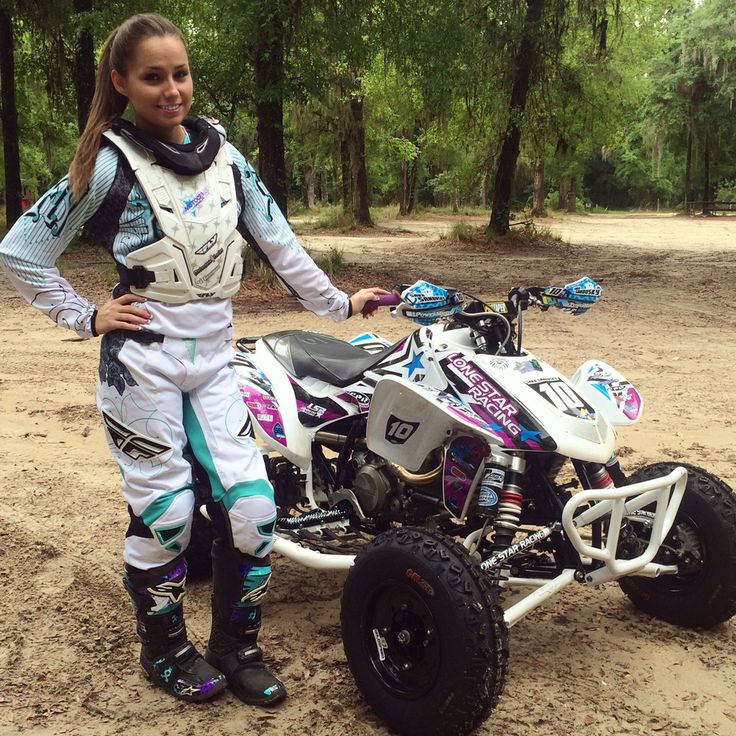 In the same article, we want to reveal to you the basics of safe riding. At first glance, there is nothing complicated in driving ATVs - you just need to steer and enjoy riding.
In the same article, we want to reveal to you the basics of safe riding. At first glance, there is nothing complicated in driving ATVs - you just need to steer and enjoy riding.
When driving over bumps, for example, those of the "wave" type, the driver must change his position all the time. So, when approaching an obstacle, you must shift your body back, otherwise you can hit the obstacle with your wheels. When driving over a bump, you need to move the body back forward, thus preventing excessive separation of the front wheels, i.e. rearing up the ATV. Then, when the rear wheels come off the ground, you need to move back again, otherwise you can fall out of the saddle, hitting your knees on the steering wheel.

Moving in a straight line at low speeds (up to 40 km/h), you can afford to relax. But at higher speeds or when passing sharp turns and slopes, the driver must move very actively. Indeed, due to the high center of gravity, short wheelbase and small width, ATVs are very prone to rollovers. In addition, if the motorcycle flies separately from the motorcyclist during falls, then the ATV most often covers the driver. Therefore, in order for ATV riding not to end with serious injuries, it is necessary to study the driving rules and strictly follow them.
ATV rider's weight is an important factor that affects machine handling.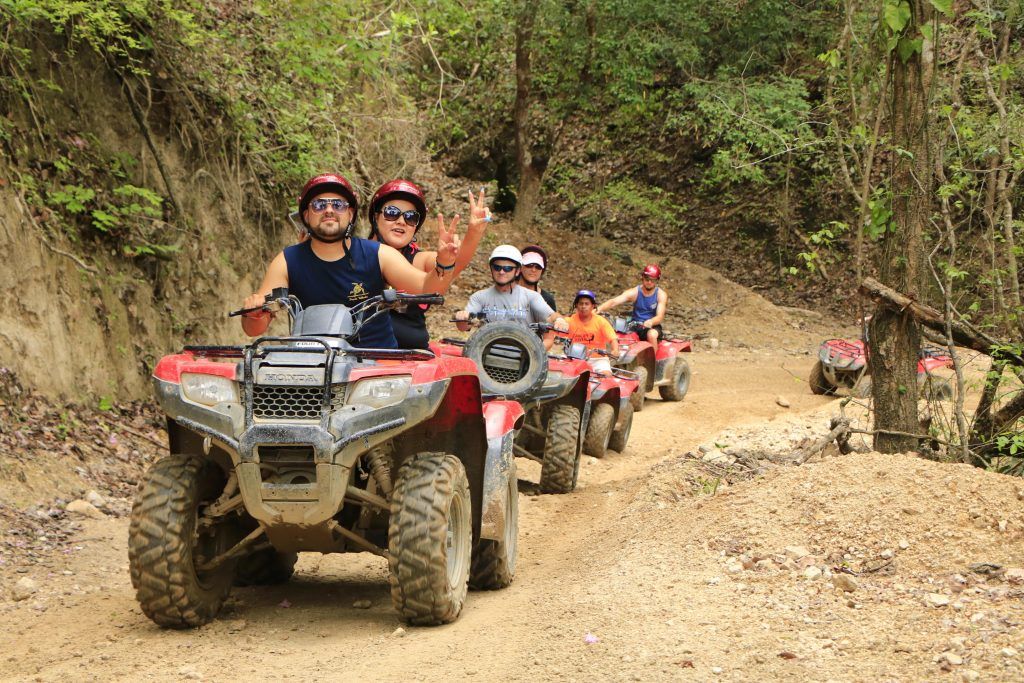 By shifting their weight, the driver can unload or load the front or rear of the ATV, thus compensating for centrifugal forces.
By shifting their weight, the driver can unload or load the front or rear of the ATV, thus compensating for centrifugal forces.
The first rule you need to learn is that when riding an ATV, you need to relax your arms. When driving, the driver can always let go of his hands, because his legs are holding him in the saddle. As the speed increases, the load on the legs also increases.
Conventionally, three racks are distinguished. The middle stance is used when driving in a straight line without turning. When opening the gas, the body must be moved forward to unload the hands. Thus, the front strut is obtained. When braking and closing the gas, the body, on the contrary, must be moved back, i.e. take a back seat. By the way, the word "stand" comes from the word "stand", and this name is not accidental. When actively riding an ATV, you do not have to sit. Standing on an ATV lowers your center of gravity. After all, there is a huge difference between the weight on a high saddle and the weight on the footrests.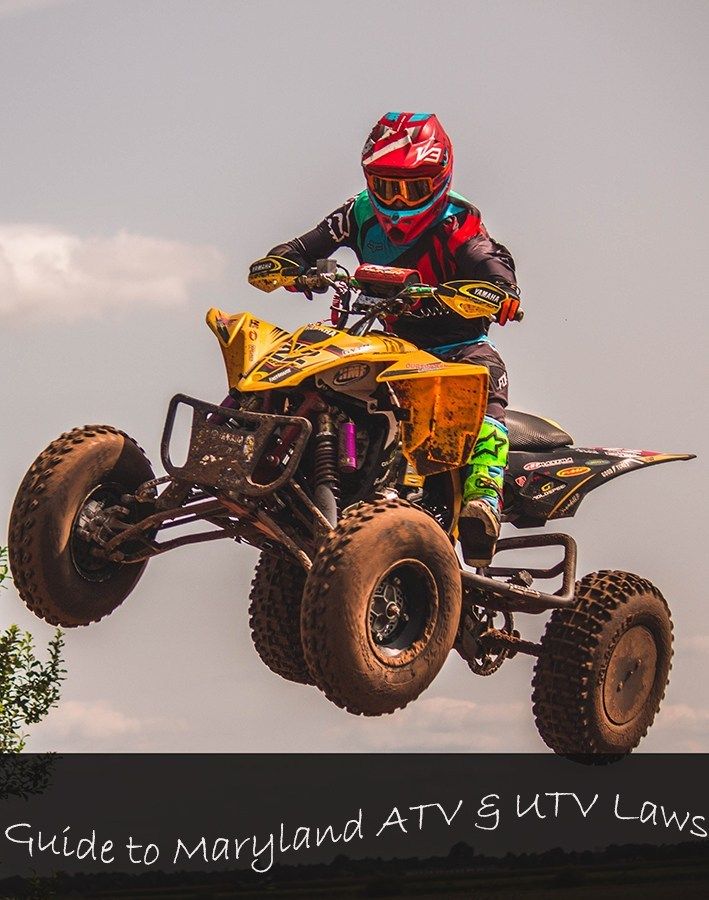 And the effect of moving the body in a standing position is much greater than from fidgeting back and forth on the saddle.
And the effect of moving the body in a standing position is much greater than from fidgeting back and forth on the saddle.
When going through a turn on a motorcycle, it is tilted inward, thus struggling with centrifugal force. But you can't do that with a quad bike. Therefore, it is necessary to use the weight of the driver. The main rule here is to always transfer the weight inside the turn. Moreover, it is necessary not only to tilt your shoulders. It is necessary to hang the entire body, including the fifth point. Only the shin and knee hold on to the saddle. Of course, if you turn at minimum speed, then you can limit yourself to turning the steering wheel.
The correct stance is characterized by slightly bent knees, elbows set apart, and a slightly arched and relaxed back. Why not stand on straight legs or keep your back straight and tense? Because bent knees allow you to absorb shock coming from uneven terrain. By the way, the force of these blows is sometimes quite enough to knock the driver out of the saddle. A straight tense back under such conditions can lead to injury to the intervertebral discs and even a compression fracture of the spine. Yes, and the internal organs with the wrong fit will have a hard time.
By the way, the force of these blows is sometimes quite enough to knock the driver out of the saddle. A straight tense back under such conditions can lead to injury to the intervertebral discs and even a compression fracture of the spine. Yes, and the internal organs with the wrong fit will have a hard time.
Active ATV riding requires good physical shape. So, in quad schools, the duration of the lesson does not exceed an hour, and at the end of the lesson, students can literally be squeezed out. And riding an ATV off-road is also an activity worthy of training in the gym.
When riding non-sport ATVs, it is best to avoid jumping. Firstly, this way you can break the ATV. Secondly, in order to safely perform such tricks, the ATV motor must have high-torque and fast response to the throttle. If, nevertheless, the jump could not be avoided, then it is necessary to land in the middle stance, but be ready to move to the back. When the wheels touch the ground, you need to slightly open the gas. It is better not to use four-wheel drive when jumping.
It is better not to use four-wheel drive when jumping.
Every time you ride an ATV, you need to practice looking into the distance. This is necessary to develop the habit of evaluating the trajectory of movement in advance. Beginners often do not have time to track the road, and at some point they are not ready to perform adequate actions. And another, very predictable obstacle, can become a problem for them.
| When moving along a slope, it is necessary to move the body in the direction opposite to the slope. On the steepest sections, full overhang should be used, such as when cornering at speed.
|
Before you start climbing, you need to pick up speed. Then the resulting inertia will allow you to smoothly drive into the steepness. If you suddenly open the gas directly on the rise, the ATV may tip over. Climbing should be in the most forward stance and on medium gas. If the incline is too steep, the ATV may roll backward when the throttle is released. In this case, you should not brake with the front axle, not the rear. If the ATV starts to roll over, you can try to jump to the side, but this acrobatic stunt is unlikely to be successful.
If the driver moves his torso out of the turn, then his centrifugal forces will pull him to the outer radius, and in order to stay in the saddle, he will need to firmly grip the steering wheel. At the same time, the ATV will definitely try to roll over. To avoid such an unpleasant situation, it is always necessary to remember a simple rule - to shift the body only in the direction of rotation.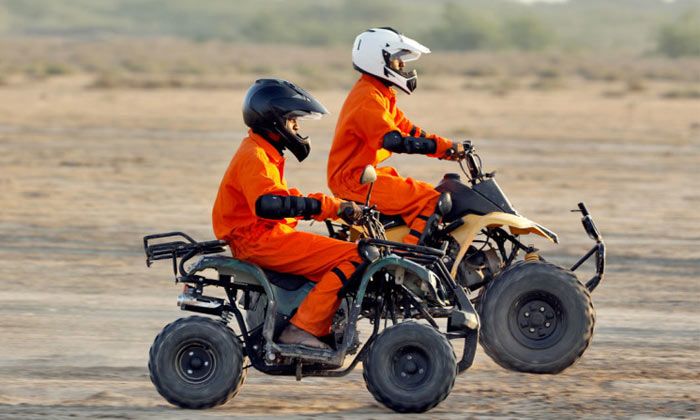 Those. if we turn to the left, then we shift the body to the left side, and vice versa.
Those. if we turn to the left, then we shift the body to the left side, and vice versa.
Descents must be made in the C-pillar. In this case, the arms must be extended and slightly bent at the elbows. There is no emphasis on the hands, you can even let them go, holding on with your feet. The steeper the descent, the more the driver must move the body back. The lower photos show the consequences of a descent in an incorrect landing. The main mistakes - the driver shifted the weight forward and pressed his hands to the body.
Every year ATVs are becoming more and more popular means of transport in our area. More often they are used for outdoor activities: walks in the wild, hunting or fishing. Various competitions among ATVs are also organized. And, of course, ATVs and ATVs are widely used in agriculture.
It is clear that ATV is a rather specific transport and many people have a question “How to learn to ride an ATV?”. In fact, everything is very simple. We also note that there are special schools in which you will be taught all the nuances of driving an all-terrain vehicle. In addition, you will need a school in order to get an ATV license.
In fact, everything is very simple. We also note that there are special schools in which you will be taught all the nuances of driving an all-terrain vehicle. In addition, you will need a school in order to get an ATV license.
On the other hand, if you plan to rent an ATV 1-2 times a year for small off-road trips, then there is no point in wasting your time and money on specialized schools. Everything can be sorted out on the spot.
Safety first! Be sure to use a helmet. Even if you are going to ride calmly and slowly, wear a helmet.
Now we climb onto the quadric and get comfortable. We start the device. On modern ATVs, this is done by pressing a button on the steering wheel. If not, then you can work as a kick-starter. Did your four-wheeled friend growl? Excellent! So you can go.
Now we give gas and go! The throttle lever, as a rule, is located on the right handle of the steering wheel, and is controlled by means of the thumb.